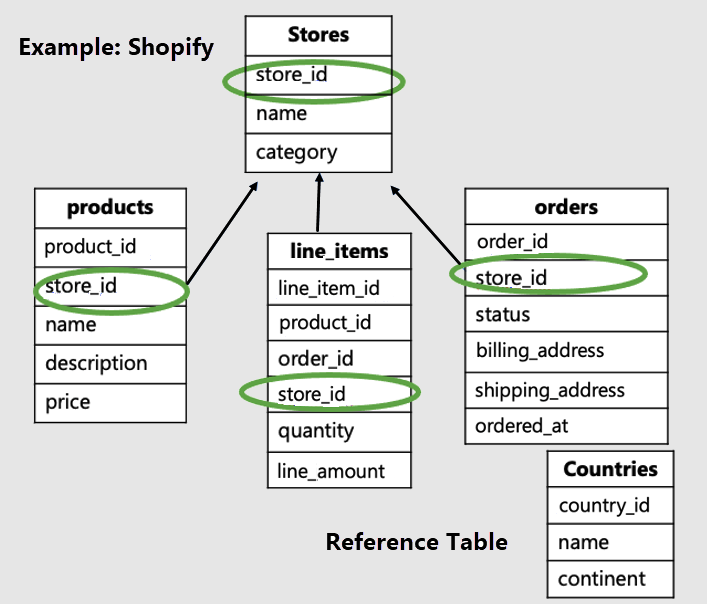Model multi-tenant SaaS apps in Azure Cosmos DB for PostgreSQL
APPLIES TO:
Azure Cosmos DB for PostgreSQL (powered by the Citus database
extension to PostgreSQL)
Tenant ID as the shard key
The tenant ID is the column at the root of the workload, or the top of the hierarchy in your data-model. For example, in this SaaS e-commerce schema, it would be the store ID:

This data model would be typical for a business such as Shopify. It hosts sites for multiple online stores, where each store interacts with its own data.
- This data-model has a bunch of tables: stores, products, orders, line items and countries.
- The stores table is at the top of the hierarchy. Products, orders and line items are all associated with stores, thus lower in the hierarchy.
- The countries table isn't related to individual stores, it is amongst across stores.
In this example, store_id, which is at the top of the hierarchy, is the
identifier for tenant. It's the right shard key. Picking store_id as the
shard key enables collocating data across all tables for a single store on a
single worker.
Colocating tables by store has advantages:
- Provides SQL coverage such as foreign keys, JOINs. Transactions for a single tenant are localized on a single worker node where each tenant exists.
- Achieves single digit millisecond performance. Queries for a single tenant are routed to a single node instead of getting parallelized, which helps optimize network hops and still scale compute/memory.
- It scales. As the number of tenants grows, you can add nodes and rebalance the tenants to new nodes, or even isolate large tenants to their own nodes. Tenant isolation allows you to provide dedicated resources.

Optimal data model for multi-tenant apps
In this example, we should distribute the store-specific tables by store ID,
and make countries a reference table.

Notice that tenant-specific tables have the tenant ID and are distributed. In our example, stores, products and line_items are distributed. The rest of the tables are reference tables. In our example, the countries table is a reference table.
-- Distribute large tables by the tenant ID
SELECT create_distributed_table('stores', 'store_id');
SELECT create_distributed_table('products', 'store_id', colocate_with => 'stores');
-- etc for the rest of the tenant tables...
-- Then, make "countries" a reference table, with a synchronized copy of the
-- table maintained on every worker node
SELECT create_reference_table('countries');
Large tables should all have the tenant ID.
- If you're migrating an existing multi-tenant app to Azure Cosmos DB for PostgreSQL, you may need to denormalize a little and add the tenant ID column to large tables if it's missing, then backfill the missing values of the column.
- For new apps on Azure Cosmos DB for PostgreSQL, make sure the tenant ID is present on all tenant-specific tables.
Ensure to include the tenant ID on primary, unique, and foreign key constraints
on distributed tables in the form of a composite key. For example, if a table
has a primary key of id, turn it into the composite key (tenant_id,id).
There's no need to change keys for reference tables.
Query considerations for best performance
Distributed queries that filter on the tenant ID run most efficiently in multi-tenant apps. Ensure that your queries are always scoped to a single tenant.
SELECT *
FROM orders
WHERE order_id = 123
AND store_id = 42; -- ← tenant ID filter
It's necessary to add the tenant ID filter even if the original filter conditions unambiguously identify the rows you want. The tenant ID filter, while seemingly redundant, tells Azure Cosmos DB for PostgreSQL how to route the query to a single worker node.
Similarly, when you're joining two distributed tables, ensure that both the tables are scoped to a single tenant. Scoping can be done by ensuring that join conditions include the tenant ID.
SELECT sum(l.quantity)
FROM line_items l
INNER JOIN products p
ON l.product_id = p.product_id
AND l.store_id = p.store_id -- ← tenant ID in join
WHERE p.name='Awesome Wool Pants'
AND l.store_id='8c69aa0d-3f13-4440-86ca-443566c1fc75';
-- ↑ tenant ID filter
There are helper libraries for several popular application frameworks that make it easy to include a tenant ID in queries. Here are instructions:
Next steps
Now we've finished exploring data modeling for scalable apps. The next step is connecting and querying the database with your programming language of choice.